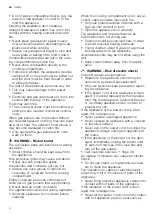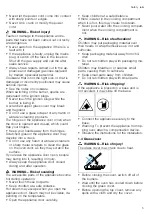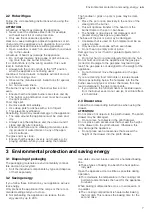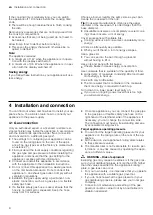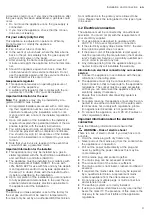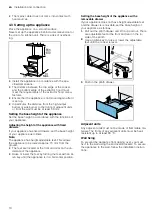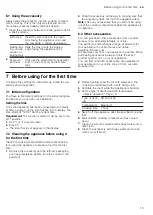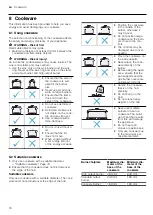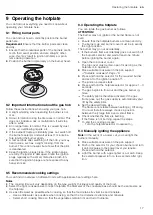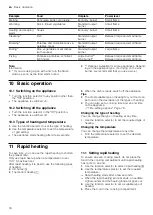
Safety
en
3
been instructed on how to use the appliance
safely and have understood the resulting
dangers.
Do not let children play with the appliance.
Children must not perform cleaning or user
maintenance unless they are at least 15 years
old and are being supervised.
Keep children under the age of 8 years away
from the appliance and power cable.
1.3 Safe use
WARNING ‒ Risk of explosion!
Escaping gas may cause an explosion. WHAT
TO DO IF YOU SMELL GAS OR IF THERE
ARE FAULTS IN THE GAS INSTALLATION
▶
Immediately shut off the gas supply or
close the gas cylinder valve.
▶
Immediately extinguish all naked flames
and cigarettes.
▶
Do not operate any light switches or appli-
ance switches.
▶
Do not pull any plugs out of any sockets.
▶
Do not use any telephones or mobile
phones within the building.
▶
Open windows and ventilate the room.
▶
Call the after sales service or the gas sup-
plier.
Escaping gas may cause an explosion. Small
amounts of gas can collect over a longer
period of time and ignite.
▶
Close the safety valve for the gas supply
when the appliance is out of use for pro-
longed periods.
Escaping gas may cause an explosion. If the
liquefied gas bottle is not upright, liquefied
propane/butane can enter the appliance. In-
tense darting flames may therefore escape
from the burners. Components may become
damaged and start to leak over time so that
gas escapes uncontrollably.
▶
Always use liquefied gas bottles in an up-
right position.
Escaping gas may cause an explosion. If the
gas pressure in your distributing pipes is
more than 20% higher than the values spe-
cified on the appliance's rating plate, a gas
leak can occur.
▶
For your own safety, it is imperative that
you operate the appliance with a suitable
gas governor.
▶
If you do not know what the gas pressure
in your gas distributing pipes is, please ask
your local gas company.
▶
Connection, maintenance and setting of the
gas governor must be carried out by an au-
thorised installation specialist.
WARNING ‒ Risk of suffocation!
Using the gas cooking appliance leads to a
build-up of heat, moisture and combustion
products in the room where the appliance is
installed.
▶
Ensure that the kitchen is sufficiently ventil-
ated, in particular when operating the gas
cooking appliance.
▶
If the appliance is used intensively and for
prolonged periods, ensure that there is ad-
ditional ventilation so that the combustion
products are safely fed to the outside, e.g.
if using existing ventilation equipment, set a
higher performance level and, at the same
time, ensure that the air is replaced with
fresh air in the room where the appliance is
installed.
▶
Consult specialist personnel when installing
additional ventilation equipment.
WARNING ‒ Risk of fire!
The appliance will become hot.
▶
Do not keep combustible objects or aero-
sol cans in drawers directly underneath the
hob.
▶
Never store or use combustible materials
(e.g. spray cans or cleaning agents) under
the appliance or in its immediate vicinity.
The cooking surface becomes very hot.
▶
Never place flammable objects on the
cooking surface or in its immediate vicinity.
▶
Never place objects on the cooking sur-
face.
Leaving fat or oil cooking on an unattended
hob can be dangerous and may lead to fires.
▶
Never leave hot oil or fat unattended.
▶
Never attempt to extinguish a fire using wa-
ter; instead, switch off the appliance and
then cover with a lid or a fire blanket.
Hob covers can cause accidents, for example
due to overheating, catching fire or materials
shattering.
▶
Do not use hob covers.
The appliance becomes very hot, fabrics and
other objects may ignite.
▶
Keep fabrics (e.g. garments or curtains)
away from the flames.
▶
Never reach over the flames.




